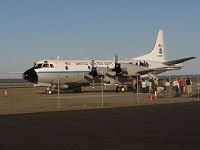 |
Personnel of SKYWARN, NOAA, and the public were treated to a tour of the NOAA WP-3D ORION hurricane research aircraft N42RF on Sunday, 29 April 2007 at Quonset State Airport, North Kingstown, Rhode Island. The airplane and crew flew a week-long five city ‘Hurricane Awareness Tour’, promoting hurricane awareness and preparedness. |
| Many folks stood in line for at least an hour as NOAA personnel guided small groups of visitors through the Turboprop WP-3D ORION. |
 |
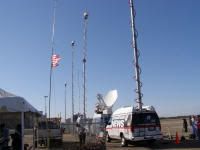 |
The day was sunny and clear. A strong northwest wind threatened to launch the tent sheltering the participants. The event was well covered by local media. |
| Robert Macedo, KD1CY, ARES SKYWARN Coordinator and Eastern Massachusetts ARES Section Emergency Coordinator, coordinates activity at the Quonset State Airport Hurricane Awareness Tour 2007. |
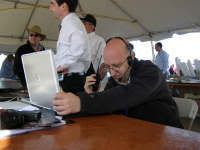 |
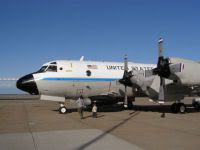 |
The Lockheed WP-3D is powered by 4 Allison T56-14 Turbo Prop Engines, each rated at 4,600 Shaft Horse Power. While not a giant airplane, it weighs in at 135,000 pounds at maximum takeoff weight packed with meteorlogical, navigation, and traffic avoidance equipment and a crew of 2 Pilots, Flight Engineer, Navigator, Flight Director (meteorologist), 2 or 3 Engineering/Electronic specialists, Radio/Avionics specialist, and up to 12 Scientist or Media personnel. Dimensions: Wingspan = 99’8″ Length = 116’10” Height = 34’3″ Operational Airspeeds: 170 – 250 knots. |
| Gust probe system and air sensors of the WP-3D ORION. |
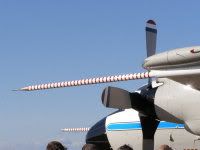 |
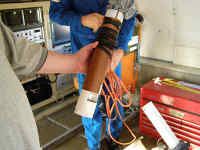 |
Gene Harriman, N1EH, Eastern Massachusetts SKYWARN Spotter, holds one of many GPS dropwindsonde Airborne Expendable Bathythermographs (AXBT’s). The device is deployed from the ORION during a mission and sends storm data back to the aircraft to be recorded and analyzed. |
| Expendable Sensor Launch Tubes in the cabin of the WP-3D ORION. Click here for more indepth information about these important expendable devices. |
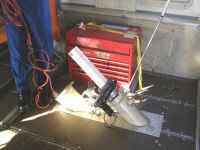 |
 |
Weather Radar Control Station aboard the NOAA WP-3D ORION. |
| “Two of the most visually prominent features of the aircraft are its belly and tail radars. The belly radome houses a high power C-band radar that scans horizontally out to a range of 200 miles. The tail cone houses an X-band Doppler radar with a vertical scan and a range of 60 miles. By combining information from these two radars scanning in perpendicular planes a three-dimensional radar image can be formed throughout each flight.”1 |
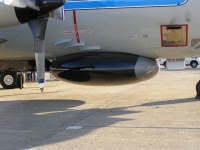 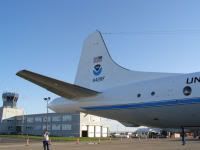 |
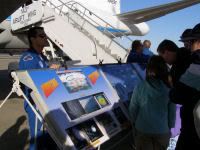 |
The WP-3D ORION crew and NOAA personnel were polite, knowledgable, and obliging. All questions from the public were answered. Children were especially interested and were told about hurricane preparedness and careers and work in meteorology and Earth sciences. |
| Our WP-3D ORIONS are deployed on International missions. Each tag in this image of the ORION fuselage shows a country visited and storm penetrations. |
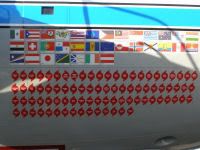 |
| In spite of the easy-going attitude of the crew of the WP-3D, remember that almost all pilots are trained to fly AWAY from storms and hurricanes. The crew of the Hurricane Hunters are trained to fly INTO storms and hurricanes, risking their lives to collect data that saves lives. We are indebted to the brave men and women of the Hurricane Hunters. It was an honor to meet you and join you for a tour of your airplane. Thank you one and all! |
1. From ‘GlobalSecurity.org’ website, http://www.globalsecurity.org/military/systems/aircraft/p-3-wp.htm
| I hope you enjoyed this article. I enjoyed writing it. All images and copy in this article were created by Eugene M. Harriman II or Samantha J.Harriman except where noted. We are solely responsible for this content. All information is accurate to the best of our knowledge. |
 |
Personnel of SKYWARN, NOAA, and the public were treated to a tour of the NOAA WP-3D ORION hurricane research aircraft N42RF on Sunday, 29 April 2007 at Quonset State Airport, North Kingstown, Rhode Island. The airplane and crew flew a week-long five city ‘Hurricane Awareness Tour’, promoting hurricane awareness and preparedness. |
| Many folks stood in line for at least an hour as NOAA personnel guided small groups of visitors through the Turboprop WP-3D ORION. |
 |
 |
The day was sunny and clear. A strong northwest wind threatened to launch the tent sheltering the participants. The event was well covered by local media. |
| Robert Macedo, KD1CY, ARES SKYWARN Coordinator and Eastern Massachusetts ARES Section Emergency Coordinator, coordinates activity at the Quonset State Airport Hurricane Awareness Tour 2007. |
 |
 |
The Lockheed WP-3D is powered by 4 Allison T56-14 Turbo Prop Engines, each rated at 4,600 Shaft Horse Power. While not a giant airplane, it weighs in at 135,000 pounds at maximum takeoff weight packed with meteorlogical, navigation, and traffic avoidance equipment and a crew of 2 Pilots, Flight Engineer, Navigator, Flight Director (meteorologist), 2 or 3 Engineering/Electronic specialists, Radio/Avionics specialist, and up to 12 Scientist or Media personnel. Dimensions: Wingspan = 99’8″ Length = 116’10” Height = 34’3″ Operational Airspeeds: 170 – 250 knots. |
| Gust probe system and air sensors of the WP-3D ORION. |
 |
 |
Gene Harriman, N1EH, Eastern Massachusetts SKYWARN Spotter, holds one of many GPS dropwindsonde Airborne Expendable Bathythermographs (AXBT’s). The device is deployed from the ORION during a mission and sends storm data back to the aircraft to be recorded and analyzed. |
| Expendable Sensor Launch Tubes in the cabin of the WP-3D ORION. Click here for more indepth information about these important expendable devices. |
 |
 |
Weather Radar Control Station aboard the NOAA WP-3D ORION. |
| “Two of the most visually prominent features of the aircraft are its belly and tail radars. The belly radome houses a high power C-band radar that scans horizontally out to a range of 200 miles. The tail cone houses an X-band Doppler radar with a vertical scan and a range of 60 miles. By combining information from these two radars scanning in perpendicular planes a three-dimensional radar image can be formed throughout each flight.”1 |
  |
 |
The WP-3D ORION crew and NOAA personnel were polite, knowledgable, and obliging. All questions from the public were answered. Children were especially interested and were told about hurricane preparedness and careers and work in meteorology and Earth sciences. |
| Our WP-3D ORIONS are deployed on International missions. Each tag in this image of the ORION fuselage shows a country visited and storm penetrations. |
 |
| In spite of the easy-going attitude of the crew of the WP-3D, remember that almost all pilots are trained to fly AWAY from storms and hurricanes. The crew of the Hurricane Hunters are trained to fly INTO storms and hurricanes, risking their lives to collect data that saves lives. We are indebted to the brave men and women of the Hurricane Hunters. It was an honor to meet you and join you for a tour of your airplane. Thank you one and all! |
1. From ‘GlobalSecurity.org’ website, http://www.globalsecurity.org/military/systems/aircraft/p-3-wp.htm
| I hope you enjoyed this article. I enjoyed writing it. All images and copy in this article were created by Eugene M. Harriman II or Samantha J.Harriman except where noted. We are solely responsible for this content. All information is accurate to the best of our knowledge. |




















